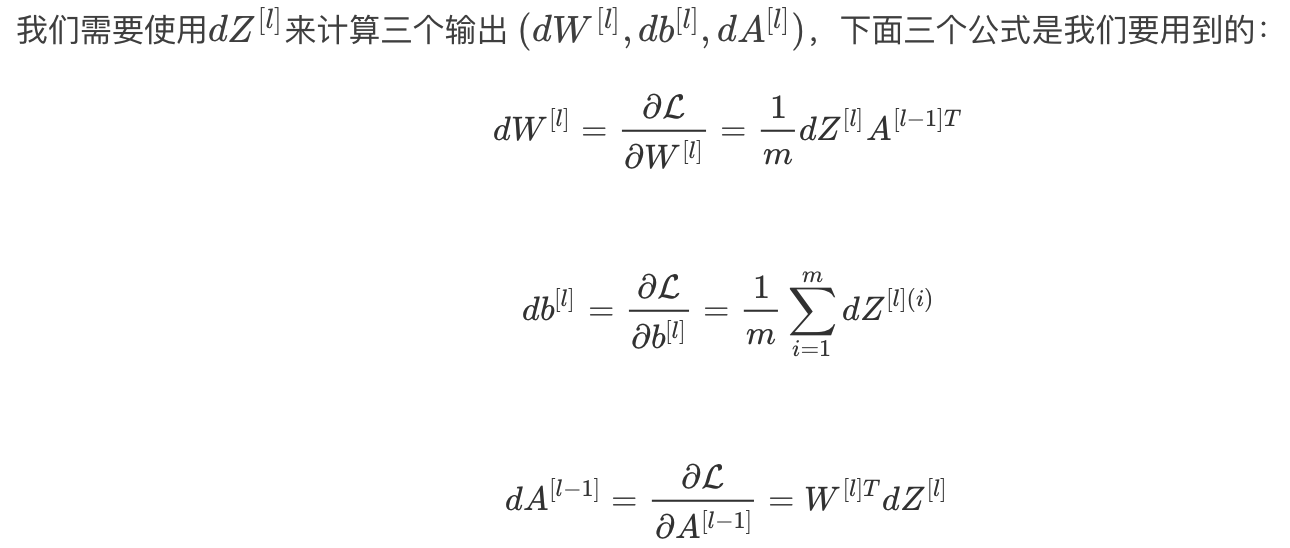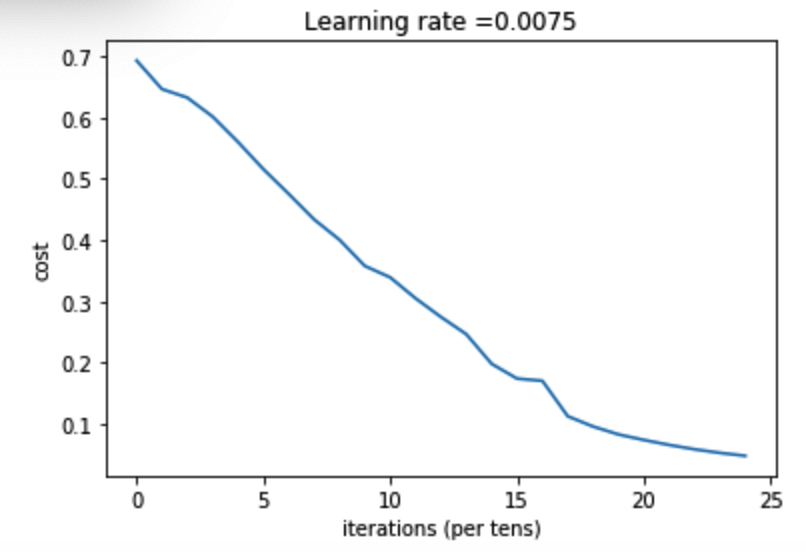吴恩达课后作业学习1-week4-homework-two-hidden-layer -1
参考:https://blog.csdn.net/u013733326/article/details/79767169
希望大家直接到上面的网址去查看代码,下面是本人的笔记
两层神经网络,和吴恩达课后作业学习1-week3-homework-one-hidden-layer——不发布不同之处在于使用的函数不同线性->ReLU->线性->sigmod函数,训练的数据也不同,这里训练的是之前吴恩达课后作业学习1-week2-homework-logistic中的数据,判断是否为猫,查看使用两层的效果是否比一层好
1.准备软件包
import numpy as np import h5py import matplotlib.pyplot as plt import testCases #参见资料包,或者在文章底部copy from dnn_utils import sigmoid, sigmoid_backward, relu, relu_backward #参见资料包 import lr_utils #参见资料包,或者在文章底部copy
为了和作者的数据匹配,需要指定随机种子
np.random.seed(1)
2.初始化参数
模型结构是线性->ReLU->线性->sigmod函数
def initialize_parameters(n_x,n_h,n_y): """ 此函数是为了初始化两层网络参数而使用的函数。 参数: n_x - 输入层节点数量 n_h - 隐藏层节点数量 n_y - 输出层节点数量 返回: parameters - 包含你的参数的python字典: W1 - 权重矩阵,维度为(n_h,n_x) b1 - 偏向量,维度为(n_h,1) W2 - 权重矩阵,维度为(n_y,n_h) b2 - 偏向量,维度为(n_y,1) """ W1 = np.random.randn(n_h, n_x) * 0.01 #随机初始化参数 b1 = np.zeros((n_h, 1)) W2 = np.random.randn(n_y, n_h) * 0.01 b2 = np.zeros((n_y, 1)) #使用断言确保我的数据格式是正确的 assert(W1.shape == (n_h, n_x)) assert(b1.shape == (n_h, 1)) assert(W2.shape == (n_y, n_h)) assert(b2.shape == (n_y, 1)) parameters = {"W1": W1, "b1": b1, "W2": W2, "b2": b2} return parameters
测试:
print("==============测试initialize_parameters==============") parameters = initialize_parameters(3,2,1) print("W1 = " + str(parameters["W1"])) print("b1 = " + str(parameters["b1"])) print("W2 = " + str(parameters["W2"])) print("b2 = " + str(parameters["b2"]))
返回:
==============测试initialize_parameters============== W1 = [[ 0.01624345 -0.00611756 -0.00528172] [-0.01072969 0.00865408 -0.02301539]] b1 = [[0.] [0.]] W2 = [[ 0.01744812 -0.00761207]] b2 = [[0.]]
3.前向传播
1)线性部分
def linear_forward(A,W,b): """ 实现前向传播的线性部分。 参数: A - 来自上一层(或输入数据)的激活,维度为(上一层的节点数量,示例的数量) W - 权重矩阵,numpy数组,维度为(当前图层的节点数量,前一图层的节点数量) b - 偏向量,numpy向量,维度为(当前图层节点数量,1) 返回: Z - 激活功能的输入,也称为预激活参数 cache - 一个包含“A”,“W”和“b”的字典,存储这些变量以有效地计算后向传递 """ Z = np.dot(W,A) + b assert(Z.shape == (W.shape[0],A.shape[1])) cache = (A,W,b) return Z,cache
测试函数linear_forward_test_case():
def linear_forward_test_case(): #随机生成A,W,b,只有一层 np.random.seed(1) """ X = np.array([[-1.02387576, 1.12397796], [-1.62328545, 0.64667545], [-1.74314104, -0.59664964]]) W = np.array([[ 0.74505627, 1.97611078, -1.24412333]]) b = np.array([[1]]) """ A = np.random.randn(3,2) W = np.random.randn(1,3) b = np.random.randn(1,1) return A, W, b
测试:
#测试linear_forward print("==============测试linear_forward==============") A,W,b = testCases.linear_forward_test_case() Z,linear_cache = linear_forward(A,W,b) print("Z = " + str(Z))
print(linear_cache
返回:
==============测试linear_forward============== Z = [[ 3.26295337 -1.23429987]] (array([[ 1.62434536, -0.61175641], [-0.52817175, -1.07296862], [ 0.86540763, -2.3015387 ]]), array([[ 1.74481176, -0.7612069 , 0.3190391 ]]), array([[-0.24937038]]))
2)线性激活部分
def linear_activation_forward(A_prev,W,b,activation): #activation为指定使用的激活函数 """ 实现LINEAR-> ACTIVATION 这一层的前向传播 参数: A_prev - 来自上一层(或输入层)的激活,维度为(上一层的节点数量,示例数) W - 权重矩阵,numpy数组,维度为(当前层的节点数量,前一层的大小) b - 偏向量,numpy阵列,维度为(当前层的节点数量,1) activation - 选择在此层中使用的激活函数名,字符串类型,【"sigmoid" | "relu"】 返回: A - 激活函数的输出,也称为激活后的值 cache - 一个包含“linear_cache”和“activation_cache”的字典,我们需要存储它以有效地计算后向传递 """ if activation == "sigmoid": Z, linear_cache = linear_forward(A_prev, W, b) A, activation_cache = sigmoid(Z) elif activation == "relu": Z, linear_cache = linear_forward(A_prev, W, b) A, activation_cache = relu(Z) assert(A.shape == (W.shape[0],A_prev.shape[1])) cache = (linear_cache,activation_cache) return A,cache
测试函数为:
def linear_activation_forward_test_case(): #单层 """ X = np.array([[-1.02387576, 1.12397796], [-1.62328545, 0.64667545], [-1.74314104, -0.59664964]]) W = np.array([[ 0.74505627, 1.97611078, -1.24412333]]) b = 5 """ np.random.seed(2) A_prev = np.random.randn(3,2) W = np.random.randn(1,3) b = np.random.randn(1,1) return A_prev, W, b
测试:
#测试linear_activation_forward print("==============测试linear_activation_forward==============") A_prev, W,b = testCases.linear_activation_forward_test_case() #使用sigmoid激活函数 A, linear_activation_cache = linear_activation_forward(A_prev, W, b, activation = "sigmoid") print("sigmoid,A = " + str(A)) print(linear_activation_cache) #使用relu激活函数 A, linear_activation_cache = linear_activation_forward(A_prev, W, b, activation = "relu") print("ReLU,A = " + str(A)) print(linear_activation_cache)
返回:
==============测试linear_activation_forward============== sigmoid,A = [[0.96890023 0.11013289]] ((array([[-0.41675785, -0.05626683], [-2.1361961 , 1.64027081], [-1.79343559, -0.84174737]]), array([[ 0.50288142, -1.24528809, -1.05795222]]), array([[-0.90900761]])), array([[ 3.43896131, -2.08938436]])) ReLU,A = [[3.43896131 0. ]] ((array([[-0.41675785, -0.05626683], [-2.1361961 , 1.64027081], [-1.79343559, -0.84174737]]), array([[ 0.50288142, -1.24528809, -1.05795222]]), array([[-0.90900761]])), array([[ 3.43896131, -2.08938436]]))
4.计算成本
def compute_cost(AL,Y): """ 实施等式(4)定义的成本函数。 参数: AL - 与标签预测相对应的概率向量,维度为(1,示例数量) Y - 标签向量(例如:如果不是猫,则为0,如果是猫则为1),维度为(1,数量) 返回: cost - 交叉熵成本 """ m = Y.shape[1] cost = -np.sum(np.multiply(np.log(AL),Y) + np.multiply(np.log(1 - AL), 1 - Y)) / m cost = np.squeeze(cost) assert(cost.shape == ()) return cost
测试函数:
def compute_cost_test_case(): Y = np.asarray([[1, 1, 1]]) aL = np.array([[.8,.9,0.4]]) return Y, aL
测试:
#测试compute_cost print("==============测试compute_cost==============") Y,AL = testCases.compute_cost_test_case() print("cost = " + str(compute_cost(AL, Y)))
返回:
==============测试compute_cost============== cost = 0.414931599615397
5.反向传播
其实是先通过线性激活部分后向传播得到dz,然后再将dz带入线性部分的后向传播得到dw,db,dA_prev
1)线性部分

根据这三个公式来构建后向传播函数
def linear_backward(dZ,cache): """ 为单层实现反向传播的线性部分(第L层) 参数: dZ - 相对于(当前第l层的)线性输出的成本梯度 cache - 来自当前层前向传播的值的元组(A_prev,W,b) 返回: dA_prev - 相对于激活(前一层l-1)的成本梯度,与A_prev维度相同 dW - 相对于W(当前层l)的成本梯度,与W的维度相同 db - 相对于b(当前层l)的成本梯度,与b维度相同 """ A_prev, W, b = cache m = A_prev.shape[1] dW = np.dot(dZ, A_prev.T) / m db = np.sum(dZ, axis=1, keepdims=True) / m dA_prev = np.dot(W.T, dZ) assert (dA_prev.shape == A_prev.shape) assert (dW.shape == W.shape) assert (db.shape == b.shape) return dA_prev, dW, db
测试函数:
def linear_backward_test_case(): #随机生成前向传播结果用于测试后向 """ z, linear_cache = (np.array([[-0.8019545 , 3.85763489]]), (np.array([[-1.02387576, 1.12397796], [-1.62328545, 0.64667545], [-1.74314104, -0.59664964]]), np.array([[ 0.74505627, 1.97611078, -1.24412333]]), np.array([[1]])) """ np.random.seed(1) dZ = np.random.randn(1,2) A = np.random.randn(3,2) W = np.random.randn(1,3) b = np.random.randn(1,1) linear_cache = (A, W, b) return dZ, linear_cache
测试:
#测试linear_backward print("==============测试linear_backward==============") dZ, linear_cache = testCases.linear_backward_test_case() dA_prev, dW, db = linear_backward(dZ, linear_cache) print ("dA_prev = "+ str(dA_prev)) print ("dW = " + str(dW)) print ("db = " + str(db))
返回:
==============测试linear_backward============== dA_prev = [[ 0.51822968 -0.19517421] [-0.40506361 0.15255393] [ 2.37496825 -0.89445391]] dW = [[-0.10076895 1.40685096 1.64992505]] db = [[0.50629448]]
2)线性激活部分
将线性部分也使用了进来
在dnn_utils.py中定义了两个现成可用的后向函数,用来帮助计算dz:
如果 g(.)是激活函数, 那么sigmoid_backward 和 relu_backward 这样计算: ![]()
- sigmoid_backward:实现了sigmoid()函数的反向传播,用来计算dz为:
dZ = sigmoid_backward(dA, activation_cache)
- relu_backward: 实现了relu()函数的反向传播,用来计算dz为:
dZ = relu_backward(dA, activation_cache)
后向函数为:
def sigmoid_backward(dA, cache): """ Implement the backward propagation for a single SIGMOID unit. Arguments: dA -- post-activation gradient, of any shape cache -- 'Z' where we store for computing backward propagation efficiently Returns: dZ -- Gradient of the cost with respect to Z """ Z = cache s = 1/(1+np.exp(-Z)) dZ = dA * s * (1-s) assert (dZ.shape == Z.shape) return dZ def relu_backward(dA, cache): """ Implement the backward propagation for a single RELU unit. Arguments: dA -- post-activation gradient, of any shape cache -- 'Z' where we store for computing backward propagation efficiently Returns: dZ -- Gradient of the cost with respect to Z """ Z = cache dZ = np.array(dA, copy=True) # just converting dz to a correct object. # When z <= 0, you should set dz to 0 as well. dZ[Z <= 0] = 0 assert (dZ.shape == Z.shape) return dZ
代码为:
def linear_activation_backward(dA,cache,activation="relu"): """ 实现LINEAR-> ACTIVATION层的后向传播。 参数: dA - 当前层l的激活后的梯度值 cache - 我们存储的用于有效计算反向传播的值的元组(值为linear_cache,activation_cache) activation - 要在此层中使用的激活函数名,字符串类型,【"sigmoid" | "relu"】 返回: dA_prev - 相对于激活(前一层l-1)的成本梯度值,与A_prev维度相同 dW - 相对于W(当前层l)的成本梯度值,与W的维度相同 db - 相对于b(当前层l)的成本梯度值,与b的维度相同 """ linear_cache, activation_cache = cache #其实是先通过线性激活部分后向传播得到dz,然后再将dz带入线性部分的后向传播得到dw,db,dA_prev if activation == "relu": dZ = relu_backward(dA, activation_cache) dA_prev, dW, db = linear_backward(dZ, linear_cache) elif activation == "sigmoid": dZ = sigmoid_backward(dA, activation_cache) dA_prev, dW, db = linear_backward(dZ, linear_cache) return dA_prev,dW,db
测试函数为:
def linear_activation_backward_test_case(): """ aL, linear_activation_cache = (np.array([[ 3.1980455 , 7.85763489]]), ((np.array([[-1.02387576, 1.12397796], [-1.62328545, 0.64667545], [-1.74314104, -0.59664964]]), np.array([[ 0.74505627, 1.97611078, -1.24412333]]), 5), np.array([[ 3.1980455 , 7.85763489]]))) """ np.random.seed(2) dA = np.random.randn(1,2) #后向传播的输入 A = np.random.randn(3,2) #存于cache中用于后向传播计算的值 W = np.random.randn(1,3) b = np.random.randn(1,1) Z = np.random.randn(1,2) linear_cache = (A, W, b) activation_cache = Z linear_activation_cache = (linear_cache, activation_cache) return dA, linear_activation_cache
测试:
#测试linear_activation_backward print("==============测试linear_activation_backward==============") AL, linear_activation_cache = testCases.linear_activation_backward_test_case() dA_prev, dW, db = linear_activation_backward(AL, linear_activation_cache, activation = "sigmoid") print ("sigmoid:") print ("dA_prev = "+ str(dA_prev)) print ("dW = " + str(dW)) print ("db = " + str(db) + "\n") dA_prev, dW, db = linear_activation_backward(AL, linear_activation_cache, activation = "relu") print ("relu:") print ("dA_prev = "+ str(dA_prev)) print ("dW = " + str(dW)) print ("db = " + str(db))
返回:
==============测试linear_activation_backward============== sigmoid: dA_prev = [[ 0.11017994 0.01105339] [ 0.09466817 0.00949723] [-0.05743092 -0.00576154]] dW = [[ 0.10266786 0.09778551 -0.01968084]] db = [[-0.05729622]] relu: dA_prev = [[ 0.44090989 -0. ] [ 0.37883606 -0. ] [-0.2298228 0. ]] dW = [[ 0.44513824 0.37371418 -0.10478989]] db = [[-0.20837892]]
6.更新参数
根据上面后向传播得到的dw,db,dA_prev来更新参数,其中 α 是学习率

函数:
def update_parameters(parameters, grads, learning_rate): """ 使用梯度下降更新参数 参数: parameters - 包含你的参数的字典,即w和b grads - 包含梯度值的字典,是L_model_backward的输出 返回: parameters - 包含更新参数的字典 参数[“W”+ str(l)] = ... 参数[“b”+ str(l)] = ... """ L = len(parameters) // 2 #整除2,得到层数 for l in range(L): parameters["W" + str(l + 1)] = parameters["W" + str(l + 1)] - learning_rate * grads["dW" + str(l + 1)] parameters["b" + str(l + 1)] = parameters["b" + str(l + 1)] - learning_rate * grads["db" + str(l + 1)] return parameters
测试函数:
def update_parameters_test_case(): """ parameters = {'W1': np.array([[ 1.78862847, 0.43650985, 0.09649747], [-1.8634927 , -0.2773882 , -0.35475898], [-0.08274148, -0.62700068, -0.04381817], [-0.47721803, -1.31386475, 0.88462238]]), 'W2': np.array([[ 0.88131804, 1.70957306, 0.05003364, -0.40467741], [-0.54535995, -1.54647732, 0.98236743, -1.10106763], [-1.18504653, -0.2056499 , 1.48614836, 0.23671627]]), 'W3': np.array([[-1.02378514, -0.7129932 , 0.62524497], [-0.16051336, -0.76883635, -0.23003072]]), 'b1': np.array([[ 0.], [ 0.], [ 0.], [ 0.]]), 'b2': np.array([[ 0.], [ 0.], [ 0.]]), 'b3': np.array([[ 0.], [ 0.]])} grads = {'dW1': np.array([[ 0.63070583, 0.66482653, 0.18308507], [ 0. , 0. , 0. ], [ 0. , 0. , 0. ], [ 0. , 0. , 0. ]]), 'dW2': np.array([[ 1.62934255, 0. , 0. , 0. ], [ 0. , 0. , 0. , 0. ], [ 0. , 0. , 0. , 0. ]]), 'dW3': np.array([[-1.40260776, 0. , 0. ]]), 'da1': np.array([[ 0.70760786, 0.65063504], [ 0.17268975, 0.15878569], [ 0.03817582, 0.03510211]]), 'da2': np.array([[ 0.39561478, 0.36376198], [ 0.7674101 , 0.70562233], [ 0.0224596 , 0.02065127], [-0.18165561, -0.16702967]]), 'da3': np.array([[ 0.44888991, 0.41274769], [ 0.31261975, 0.28744927], [-0.27414557, -0.25207283]]), 'db1': 0.75937676204411464, 'db2': 0.86163759922811056, 'db3': -0.84161956022334572} """ np.random.seed(2) W1 = np.random.randn(3,4) b1 = np.random.randn(3,1) W2 = np.random.randn(1,3) b2 = np.random.randn(1,1) parameters = {"W1": W1, "b1": b1, "W2": W2, "b2": b2} np.random.seed(3) dW1 = np.random.randn(3,4) db1 = np.random.randn(3,1) dW2 = np.random.randn(1,3) db2 = np.random.randn(1,1) grads = {"dW1": dW1, "db1": db1, "dW2": dW2, "db2": db2} return parameters, grads
测试:
#测试update_parameters print("==============测试update_parameters==============") parameters, grads = testCases.update_parameters_test_case() parameters = update_parameters(parameters, grads, 0.1) print ("W1 = "+ str(parameters["W1"])) print ("b1 = "+ str(parameters["b1"])) print ("W2 = "+ str(parameters["W2"])) print ("b2 = "+ str(parameters["b2"]))
返回:
==============测试update_parameters============== W1 = [[-0.59562069 -0.09991781 -2.14584584 1.82662008] [-1.76569676 -0.80627147 0.51115557 -1.18258802] [-1.0535704 -0.86128581 0.68284052 2.20374577]] b1 = [[-0.04659241] [-1.28888275] [ 0.53405496]] W2 = [[-0.55569196 0.0354055 1.32964895]] b2 = [[-0.84610769]]
7.整合函数——训练
开始训练数据并得到最优参数
def two_layer_model(X,Y,layers_dims,learning_rate=0.0075,num_iterations=3000,print_cost=False,isPlot=True): """ 实现一个两层的神经网络,【LINEAR->RELU】 -> 【LINEAR->SIGMOID】 参数: X - 输入的数据,维度为(n_x,例子数) Y - 标签,向量,0为非猫,1为猫,维度为(1,数量) layers_dims - 层数的向量,维度为(n_y,n_h,n_y) learning_rate - 学习率 num_iterations - 迭代的次数 print_cost - 是否打印成本值,每100次打印一次 isPlot - 是否绘制出误差值的图谱 返回: parameters - 一个包含W1,b1,W2,b2的字典变量 """ np.random.seed(1) grads = {} costs = [] (n_x,n_h,n_y) = layers_dims """ 初始化参数 """ parameters = initialize_parameters(n_x, n_h, n_y) W1 = parameters["W1"] b1 = parameters["b1"] W2 = parameters["W2"] b2 = parameters["b2"] """ 开始进行迭代 """ for i in range(0,num_iterations): #前向传播 A1, cache1 = linear_activation_forward(X, W1, b1, "relu") A2, cache2 = linear_activation_forward(A1, W2, b2, "sigmoid") #计算成本 cost = compute_cost(A2,Y) #后向传播 ##初始化后向传播 dA2 = - (np.divide(Y, A2) - np.divide(1 - Y, 1 - A2)) ##向后传播,输入:“dA2,cache2,cache1”。 输出:“dA1,dW2,db2;还有dA0(未使用),dW1,db1”。 dA1, dW2, db2 = linear_activation_backward(dA2, cache2, "sigmoid") dA0, dW1, db1 = linear_activation_backward(dA1, cache1, "relu") ##向后传播完成后的数据保存到grads grads["dW1"] = dW1 grads["db1"] = db1 grads["dW2"] = dW2 grads["db2"] = db2 #更新参数 parameters = update_parameters(parameters,grads,learning_rate) W1 = parameters["W1"] b1 = parameters["b1"] W2 = parameters["W2"] b2 = parameters["b2"] #打印成本值,如果print_cost=False则忽略 if i % 100 == 0: #记录成本 costs.append(cost) #是否打印成本值 if print_cost: print("第", i ,"次迭代,成本值为:" ,np.squeeze(cost)) #迭代完成,根据条件绘制图 if isPlot: plt.plot(np.squeeze(costs)) plt.ylabel('cost') plt.xlabel('iterations (per tens)') plt.title("Learning rate =" + str(learning_rate)) plt.show() #返回parameters return parameters
我们现在开始加载数据集,图像数据集的处理可以参照吴恩达课后作业学习1-week2-homework-logistic
train_set_x_orig , train_set_y , test_set_x_orig , test_set_y , classes = lr_utils.load_dataset() train_x_flatten = train_set_x_orig.reshape(train_set_x_orig.shape[0], -1).T test_x_flatten = test_set_x_orig.reshape(test_set_x_orig.shape[0], -1).T train_x = train_x_flatten / 255 train_y = train_set_y test_x = test_x_flatten / 255 test_y = test_set_y
数据集加载完成,开始正式训练:
n_x = 12288 n_h = 7 n_y = 1 layers_dims = (n_x,n_h,n_y) parameters = two_layer_model(train_x, train_set_y, layers_dims = (n_x, n_h, n_y), num_iterations = 2500, print_cost=True,isPlot=True)
返回:
第 0 次迭代,成本值为: 0.6930497356599891 第 100 次迭代,成本值为: 0.6464320953428849 第 200 次迭代,成本值为: 0.6325140647912678 第 300 次迭代,成本值为: 0.6015024920354665 第 400 次迭代,成本值为: 0.5601966311605748 第 500 次迭代,成本值为: 0.515830477276473 第 600 次迭代,成本值为: 0.47549013139433266 第 700 次迭代,成本值为: 0.4339163151225749 第 800 次迭代,成本值为: 0.40079775362038866 第 900 次迭代,成本值为: 0.3580705011323798 第 1000 次迭代,成本值为: 0.33942815383664127 第 1100 次迭代,成本值为: 0.30527536361962654 第 1200 次迭代,成本值为: 0.2749137728213016 第 1300 次迭代,成本值为: 0.2468176821061485 第 1400 次迭代,成本值为: 0.19850735037466094 第 1500 次迭代,成本值为: 0.17448318112556652 第 1600 次迭代,成本值为: 0.17080762978096245 第 1700 次迭代,成本值为: 0.11306524562164728 第 1800 次迭代,成本值为: 0.09629426845937152 第 1900 次迭代,成本值为: 0.08342617959726863 第 2000 次迭代,成本值为: 0.07439078704319081 第 2100 次迭代,成本值为: 0.06630748132267934 第 2200 次迭代,成本值为: 0.05919329501038173 第 2300 次迭代,成本值为: 0.05336140348560557 第 2400 次迭代,成本值为: 0.048554785628770185
图示:

8.预测
def predict(X, y, parameters): """ 该函数用于预测L层神经网络的结果,当然也包含两层 参数: X - 测试集 y - 标签 parameters - 训练模型得到的最优参数 返回: p - 给定数据集X的预测 """ m = X.shape[1] n = len(parameters) // 2 # 神经网络的层数 p = np.zeros((1,m)) #根据参数前向传播 probas, caches = L_model_forward(X, parameters) for i in range(0, probas.shape[1]): if probas[0,i] > 0.5: p[0,i] = 1 else: p[0,i] = 0 print("准确度为: " + str(float(np.sum((p == y))/m))) return p
预测函数构建好了我们就开始预测,查看训练集和测试集的准确性:
predictions_train = predict(train_x, train_y, parameters) #训练集
predictions_test = predict(test_x, test_y, parameters) #测试集
返回:
准确度为: 1.0 准确度为: 0.72
可见两层的训练效果比单层的logistic回归的效果要好一些




 浙公网安备 33010602011771号
浙公网安备 33010602011771号